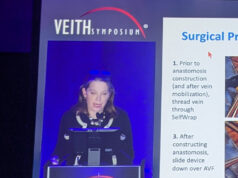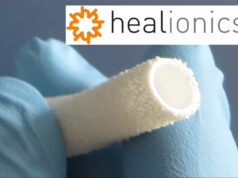
The third EVA Meeting (23–24 June, Patras, Greece) sought to build on international collaboration and science, one of the stated aims of the meeting directors, Dimitrios Karnabatidis, Konstantinos Katsanos and Panos Kitrou (University of Patras, Patras, Greece). With the programme carefully constructed to build on the needs emerging from previous editions of the meeting, it reflected new clinical data, documented the sharp rise in use of ultrasound in vascular access management, and touched on harnessing augmented reality and artificial intelligence (AI) in the field. A session set aside to ‘the way ahead’ in vascular access brought a flavour of what the future holds into the present.
Datapoints and designs
In a 1st@EVA presentation, Gürkan Sengölge (Medical University of Vienna, Vienna, Austria) elaborated on a single-centre experience of the inside-out technique, which is a novel approach to facilitate upper body central venous access in patients with venous obstructions or other conditions that preclude access by conventional methods. Merit Medical recently acquired the Surfacer inside-out access catheter system from Bluegrass Vascular Technologies.
Sengölge set the scene to explain how his centre, which serves over 900 dialysis patients and more than 800 predialysis patients per year, has observed an increase in difficult central venous access cases. The team was therefore looking for “a tool and strategy to preserve vascular real estate as well as to gain safe vascular access in patients with end-stage vascular access”.
Selecting from 103 patients with a thoracic central venous occlusion, 97 patients were eligible for the procedure. Accounting for repeat procedures, there were 105 inside-out procedures performed and 104 central venous catheters successfully placed with no procedure based complications. In eight patients HeRO graft (Merit Medical) became an option in combination with Surfacer and was placed in the same session or after bridging.
“Always right, never subclavian was implemented as our centre strategy. In 67 patients who were running out of vessels, with rapidly diminishing access options, central venous catheters were quickly and safely implanted. Importantly, significant vascular real estate preservation in patients facing long-term access needs was achieved because thoracic central veins on the left side that are more prone to stenosis or occlusions were not used,” he said.
Kitrou set the context for Renal Interventions: “This is a unique device and procedure that offers a crucial bail-out option to no-option patients. Learning from the extensive experience of Sengölge, who has performed over 100 cases with the Surfacer is of paramount importance.”
Raphaël Coscas (Ambroise Paré Hospital and Paris-Saclay University, Paris, France) also presented the ABISS trial comparison with other studies in another 1st@ EVA. He underlined that in the ABISS trial, the primary endpoint of six-month primary patency was not met in the intention-to-treat analysis. It was however, met in the prespecified per-protocol analysis where the drug-coated balloon (DCB; Lutonix, BD) was superior to plain balloon angioplasty at three, six and 12 months. He compared post-hoc analyses based on analysis methods used in other large DCB trials to show “that different methods of analysis yield different conclusions”.
“DCB demonstrates a positive effect over plain balloon angioplasty in terms of reinterventions, restenosis and dialysis circuit patency at three months and for arteriovenous fistula (AVF) flow at six months. This benefit is lost during follow-up,” he clarified via video link.
Kitrou noted: “Inconsistency of endpoints in studies is always an obstacle when trying to understand the results. Comparing studies by providing common endpoints is as important as the results themselves. To that end, this presentation is of extremely high value.”
Resounding favour for ultrasound
Jose Abadal (Hospital Universitario Severo Ochoa, Madrid, Spain) set out a robust case for the use of Doppler ultrasound before, during and after intervention.
“Doppler ultrasound should be performed before any endovascular treatment. Only ultrasound will determine the haemodynamic significance of a stenosis, and even the existence of stenosis; it characterises the type of stenosis, and it has treatment implications. Sometimes exovascular causes of stenosis are diagnosed. “When it comes to intraprocedural use, during intervention, ultrasound is my first image guidance choice because it is mandatory for real sizing of devices and allows us to be more precise during the intervention,” he said.
Technical success is interlinked with clinical success and should rest on adopting new endpoints that take into account haemodynamics, commented Abadal. When relying solely on anatomic endpoints of successful angioplasty (<30% residual stenosis on angiography), up to 20–30% of patients fail to show an increase in blood flow afterwards in dialysis, he explained.
“Previous angioplasty studies that do not consider haemodynamics as endpoints are half-blind. Guidelines should incorporate doppler criteria like access volume flow (VF), peak systolic velocity (PSV) and minimal luminal diameter beside angiography and of course patients’ clinic visits, to decide whether to treat or not a stenosis,” he said.
The haemodynamic component of vascular access functionality, which is the volume flow (VF) measurement (measurement of blood flow velocity employing Doppler techniques in combination with calculation of the approximate cross-sectional vessel area) turned into a major talking point at the EVA meeting.
Stavros Spiliopoulos (National and Kapodistrian University of Athens, Athens, Greece) raised the point that intraprocedural VF can be used to quantify and optimise endovascular dialysis access treatment outcomes. Is this the ultimate tool, he rhetorically enquired. “Volume flow helps to determine the haemodynamic significance of lesions; baseline VF is a novel functional outcome of endovascular treatment that can impact surveillance. It is also a great intraprocedural decision-making tool that has changed my practice, and we need a randomised controlled trial to compare it to standard assessment,” he said.
VOLA II, a prospective, multicentre study of 100 AVFs revealed post-procedural VF is an independent predictor of patency, and has been submitted for publication. VF gain of 413ml/min is the optimal cut-off point for predicting improved patency (p=0.0014), Spiliopoulos stated, reiterating that as witnessed already in cardiology, “it is time to move over from anatomical to physiological” endpoints.
“It became apparent from the previous EVA meeting that ultrasound is a valuable tool and needs further utilisation in vascular access. The session tried to provide evidence in the field and combined with the DELPHI initiative is expected to lead to an important and valuable discussion,” commented Kitrou.
Any conclusions on central venous stenosis and occlusions?
“Central venous stenosis and occlusion is an integral part of everyday practice for physicians treating haemodialysis patients both with catheters and vascular access. So, knowing how to access and treat these lesions, and being aware of the techniques and the device available, is a must. Even more important is to be aware of the potential adverse events and complications which, in this anatomic region, can be very serious. This is why, the majority of the “Morbidity and Mortality” cases in the corresponding session were on central veins. Discussing these rare but important complications, learning from problems other peers face, helps awareness and also to avoid falling into similar traps,” Kitrou said.
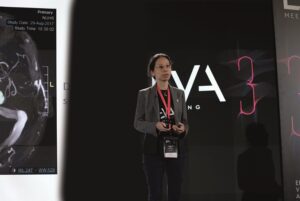
Jackie Ho Pei (National University Heart Centre, Singapore) presented on the histopathologic and haemodynamic background of central venous disease and provided her tips on crossing the lesion. Kitrou further reported on treatment options, prioritising that high-pressure balloon angioplasty remains the optimal treatment, with DCB perhaps offering an extra benefit. Bare metal stents should be avoided, but this remains a question mark for dedicated venous stents, he suggested. “Covered stents provide a benefit but remain a bail-out option. We need more dedicated prospective trials on the adjunctive treatments,” Kitrou noted.
Dheeraj Rajan (University of Toronto, Toronto, Canada) presented a case on ‘a not-so-routine’ superior vena cava angioplasty and Bart Dolmatch (Palo Alto, USA) unspooled a case detailing ‘a series of unfortunate events’ in the Morbidity and Mortality session.
Can putting AI (and machine learning) in play keep treatments precise and costs at bay?
Sparking a recurring current discussion on augmented reality, AI and machine learning in medicine, Jose Ibeas (Parc Taulí University Hospital, Barcelona, Spain), noted that evidence-based medicine is beginning to be replaced by data-driven medicine, and that “vascular access is not going to run away from it.”
“We are immersed in a paradigm shift and should be aware of it. […] Vascular access, both due to the diversity of variables involved and the complexity of its interpretation, becomes an ideal field for the use of AI. The results of the first studies are promising, but a validation process is required. We are in a phase in which […] the terrible speed of its progress requires necessary training both to be able to carry out research, to interpret the results and apply them,” he said.
The director of the Program for Promotion & Development of AI in the Catalan Health System, deconstructed that “essentially, AI consists of mathematical models that look for patterns in data and generate algorithms that learn on their own. By analysing lots of patient data and looking for patterns, AI learns to find which groups are most at risk of disease, as well as predict a patient’s outcome or response to treatment. AI allows us to know the evolution of a disease or the response of a patient to a treatment, but only a few people are aware of the opportunities and dangers inherent in its use. In fact, as with any medical device, this type of tool should be validated before its use, just like a new drug with prior clinical trials,” he said.
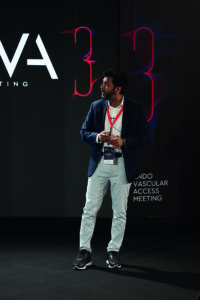 Saravanan Balamuthusamy (PPG Healthcare, Fort Worth, USA) who took to the podium to discuss financial realities of vascular access management, presented on harnessing machine learning (ML) as a tool towards cost-effectiveness. “Predictive analytics utilising machine learning can have numerous applications in AVF access. These include prediction of the likelihood of a successful AVF with an approximate maturation period, which would be time to cannulation. It may also help in identifying patients who might be candidates for successful endovascular AVF (endoAVF) creation, as well as in predicting patients for an early arteriovenous graft (AVG) as opposed to “fistula first”. Predicting risk for access dysfunction due to inflow versus outflow issues is also a possibility, as is estimating the need for reintervention in patients with arteriovenous access stenosis. Lastly, it may help in calculating the cost of arteriovenous access creation and maintenance at a patient and group level,” he previously wrote in Renal Interventions.
Saravanan Balamuthusamy (PPG Healthcare, Fort Worth, USA) who took to the podium to discuss financial realities of vascular access management, presented on harnessing machine learning (ML) as a tool towards cost-effectiveness. “Predictive analytics utilising machine learning can have numerous applications in AVF access. These include prediction of the likelihood of a successful AVF with an approximate maturation period, which would be time to cannulation. It may also help in identifying patients who might be candidates for successful endovascular AVF (endoAVF) creation, as well as in predicting patients for an early arteriovenous graft (AVG) as opposed to “fistula first”. Predicting risk for access dysfunction due to inflow versus outflow issues is also a possibility, as is estimating the need for reintervention in patients with arteriovenous access stenosis. Lastly, it may help in calculating the cost of arteriovenous access creation and maintenance at a patient and group level,” he previously wrote in Renal Interventions.
Kitrou said: “This new era coming from advancements in other scientific fields is very exciting and it is important to start understanding and hopefully implementing these advancements in the near future in vascular access with a view to provide better care for dialysis patients.”
Here comes the future
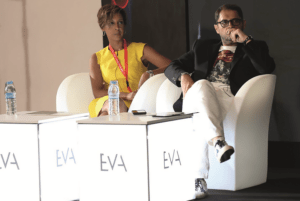
Monnie Wasse (Rush University Medical Center, Chicago, USA) issued a futuristic outlook on new generation covered grafts for vascular access, first outlining the broad clinical frameworks that prompt teams to consider using these devices. These begin with taking into account the patient’s life plan. Then, “If patients have been on dialysis with prolonged CVC [central venous catheter] exposure; have had previous failed AVF(s); limited vasculature for AVF creation or if patient survival is estimated to be between one and two years [AVG use may be considered appropriate].”
With regards to materials, there are synthetic nonbiodegradable materials such as expanded polytetraflorethylene (ePTFE/Gore-Tex), polyurethane and dacron in use for the covering. Xenografts, that are chemically fixed and do not remodel, repopulate with host cells or heal. These include bovine carotid artery and bovine mesenteric vein, Wasse explained, quoting from Lawson et al’s 2021 paper in Nature Reviews Nephrology. She then dwelt on the aXess graft (Xeltis), a novel, restorative, bioabsorbable implant made of electrospun supramolecular polymers. Previous coverage from Renal Interventions reveals that the device essentially allows the body to heal itself. Immediately after implantation, it acts as a functional haemodialysis AVG and, over time, provides a mechanical and structural scaffold for cell ingrowth propelled by the body’s natural healing process. The result is a living vessel that enables immediate cannulation, potentially better patency rates, lower bleeding times after needle removal, and lower access site infection rates, compared to commercially available AVGs.
The investigational haemodialysis graft—the InnAVasc Graft (IAVG)—which is designed to be used immediately post-implant and was in 2022 acquired by Gore also came in for a mention by Wasse, as did the InterGraft (Phraxis), implantable device that provides immediate access to dialysis and helps to prevent repeated access surgeries. This transcatheter delivered venous anastomotic connector offers a unique, minimally invasive approach to vascular access.
Further research is also underway including those like the European Union-funded Telegraft project that is investigating a “promising solution for patients who do not have direct access to haemodialysis infrastructures”. The project proposes to “develop a smart AVG that by biomimicry and drug-eluting properties minimises the risk of thrombosis and infection and also allows blood flow monitoring and early detection of inflammation and infection. It essentially serves as a telemonitoring system to allow early minimally invasive prevention of serious complications” per the Europa website.
Wasse then turned to tissue engineered dialysis AVGs that offer strong, and immunologically inert options to provide an alternative to autologous vessels. “Decellularised vessels mimic the vasculature,” she said, pointing to evidence acquired with the Human Acellular Vessel (HAV) graft (Humacyte) that has long-term phase two data showing no infections of the HAV during a five-year follow-up period, with the device being well tolerated and non-immunogenic. Recently published data on TRUE AVC (Vascudyne) a tissue-engineered vascular conduit also came in for some airtime. A recently published study demonstrates initial safety, mechanical durability and lack of immune response with TRUE AVC. It also shows potential as an off-the-shelf blood vessel conduit for clinical use. A first-in-human, five patient study, demonstrated no infections or aneurysms at 26-week follow-up and 80% primary patency; and 100% secondary patency. “An off-the-shelf, completely biological acellular vascular conduit, able to repopulate with the recipient’s own cells and become a living vessel in vivo, may provide long-term functional patency and low complication rates similar to the native fistula, while avoiding maturation failures and early thrombosis,” the authors Ebner et al, with Wasse as senior author on the research team, reported in the Journal of Vascular Access.
Wasse told EVA delegates that while challenges relating to commercial scaling, cost, and regulatory approval remain, bioengineered AVGs could represent the future. “Studies to date show safety, non-immunogenicity, very low infection rates and good functionality for dialysis. Ongoing evaluation of cellular and decellularised devices support their use in patients at high risk of AVF non-maturation or access infection. For haemodialysis, the technology offers lower infection than synthetic AVGs and earlier use than AVF,” she said.

Dolmatch (Palo Alto Medical Foundation and professor emeritus, UT Southwestern Medical Center, Dallas, USA) then examined “next generation stents” in ‘the way ahead’ session clarifying that there is currently just one study of a bare metal stent (Supera, Abbott) in enrolment phase, with the primary outcome measure being the number of patients with primary patency of juxta-anatostomic stenosis of the treatment site at three months. He called into question outcome measures with short periods of follow-up. Moving on to drug-eluting stents (DES), while stating that “an anti-proliferative coating might be a very good idea”, he referenced the scarce published data including a small study with the Eluvia stent (Boston Scientific) that does signal positively, before stepping over to covered stent usage, which is backed by data from multicentre randomised controlled trials such as the REVISE and RENOVA trials (the former used Viabahn [WL Gore] and the latter the Flair graft [BD] as well as the AVeVA and AVeNEW trials (which used Covera, BD). “The Achilles’ heel of covered stents is edge restenosis, the dominant cause of covered stent restenosis,” Dolmatch said. Advances such as the Wrapsody cell impermeable endoprosthesis (Merit Medical), which is being assessed in the US Investigational Device Exemption (IDE) WAVE trial and has recently completed enrolment are underway, he noted.
“Bare metal stents are rarely used in arteriovenous access due to in-stent restenosis. There is scant data on DES. [At this point] We cannot tell. Covered stents have revolutionised AV access intervention. Even though these devices are superior to percutaneous transluminal angioplasty in many instances, there is room for improvement. New stent and graft technology is on the horizon,” he continued.
Kitrou concluded his commentary with: “An important part of our science is to know not only what is available, but also what we expect to see in the future. I think every meeting should have a session like this one, where physicians can see what is happening in the background, so that we can discuss what is not widely known yet.”

